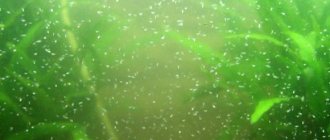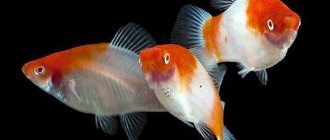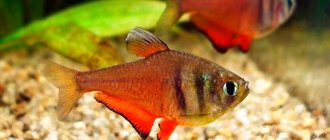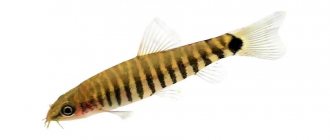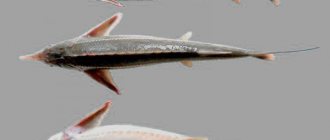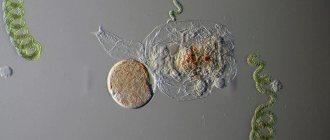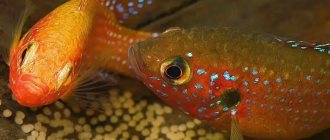Artemia is eaten by fish swimming in the water column and at the bottom. It is good because it is easy to breed at home. It contains many trace elements, vitamins, amino acids, and lipids. For breeding you will need crustacean eggs, which can be bought in the store. They come in two types: ordinary and decapsulated.
Decapsulated eggs do not have a protective shell, but do not die during breeding. Due to the lack of protection, the crustacean grows fatter. After all, he does not need to waste energy on breaking the shell. But you need to be careful with such eggs. The fish will happily eat such brine shrimp. But pets that have fallen to the bottom will not eat decapsulated eggs. For breeding Artemia at home, only eggs that have been stored for no more than 2-3 years are suitable. In this case, 50-80% of the crustaceans will hatch.
Preparing to breed artemia at home
First of all, buy all the necessary equipment and materials to create a Weiss apparatus:
- 2 liter plastic bottle with cone neck
- bottle stand
- compressor, tubes, sprayer
- crustacean eggs
- sea or table salt
- lamp (table lamp is suitable, will also serve as a heater)
- thermometer
Wash well and then dry the selected container. Cut off the bottom and adjust the stand so that the bottle does not fall. Drill a hole in the lid for the straw, put the sprayer on it and insert it into the compressor. Air flow is necessary to enrich the incubation environment with oxygen and remove carbon dioxide (metabolic products), as well as to constantly mix the eggs in the water column. Taper is necessary to avoid dead zones during mixing. There must be an outlet not far from the installation site into which you can connect the necessary equipment.
Add salt to the settled water (20 g per 0.5 l of water). Use a refractometer to measure the salinity of the water in the container. If it is not there, then add salt to the settled water, and then pour it into the container. By selecting the lamp power, achieve a water temperature of about 25-28 degrees. As soon as the temperature is constant, you can stock the crustaceans.
If the temperature and salinity of the water are favorable, the brine shrimp will hatch within 24 hours.
What is needed?
- To breed brine shrimp, I use a plastic, cut-off five-liter bottle. In the lid of which I made a hole for the hose.
- Usually, I culture 60% dry Artemia cysts.
- Artemia is a crustacean that inhabits shallow sea waters and salt lakes, so breeding artemia is carried out in a saline solution. You need table salt, not iodized.
- 3 liters of tap water, no need to stand, the main thing is that the water is at room temperature.
Ready-made kits for breeding brine shrimp
Ready-made kits for growing crustaceans are available for sale. The Sera company offers aquarists a basic set, the Sera Artemia Breeding Kit.
Sera Artemia Breeding Kit
A more advanced set is offered by the German brand JBL - a kit for growing crustaceans JBL ArtemioSet. The set includes a flask, stand, compressor, faucet, tubes, sieve. It is unique in that in addition to the set you can buy many accessories, such as one or more JBL Artemio 1 flasks, 0.15/0.3/0.6/1.0 mm Artemio 4 sieves, eggs, crustacean food and salt.
JBL Artemio 1 (JBL ArtemioSet expansion container)
Description and natural habitat
Artemia (Artemia salina) is a branchial crustacean, pink in color, adults have 3 eyes, 11 pairs of legs. Males have an enlarged pair of claws, which they use as gripping organs in mating.
Artemia grows up to 12-18 mm, lives 4-6 months. Crustaceans are heterosexual; in the absence of males, females can reproduce by parthenogenesis (a form of sexual reproduction of organisms in which eggs develop into an adult organism without fertilization). Males have claws on their heads, while females have an egg sac containing up to 200 eggs. The blood of crustaceans contains hemoglobin, just like vertebrates.
Photo gallery of Artemia fish food:
Artemia goes through more than one stage of development, in any of them it is suitable for feeding aquarium inhabitants:
- Cysts (eggs) contain a lot of protein, ideal for fry and small fish.
- Nauplii are small crustaceans that have recently emerged into the world.
- Adults - for medium and large underwater inhabitants.
There are two types of eggs - thin-walled (hatch immediately) and thick-shelled (remain dormant for a long time). They hatch into small individuals with one light-sensitive eye, the length of the nauplii is 0.5 mm. Later, two more eyes appear. Artemy cysts can withstand boiling and very low temperatures. The shell protects from frost in winter and heat in summer.
Crustaceans never sleep; for their vital functions they need constant wakefulness. These creatures are very ancient, living on Earth for more than 100 million years.
In nature, Artemia prefers salty reservoirs, located mainly in resort areas. Crustaceans form healing mud; they can withstand high concentrations of salt. Their food is green algae and phytoplankton. The distribution area is extensive - water bodies of the USA, Spain, Italy, Russia, Kazakhstan, Ukraine.
How to prepare brine shrimp
After a week, the small cysts will grow and become excellent food for adult aquarium fish. Artemia nauplii are used as food for the fry, which are caught on the second day after the eggs are placed in the water. To catch live brine shrimp, you need to turn off the filter and wait 10 minutes. During this time, empty cysts will begin to float on the surface, unhatched ones will settle to the bottom, and living ones will float in the middle layers of the water.
To catch breeding crustaceans, shine a flashlight in one direction. As soon as the crustaceans arrive, catch them with a net. The finer the mesh on the net, the more artemia you can catch. After washing the caught animals with running water, put them into an aquarium with fish. Artemia will begin to swim, and the fish will hunt for them.
If there is a lot of brine shrimp, you can freeze it. To do this, catch it and package it in bags. Then put it in the freezer. Before feeding the fish, break off the required piece and give it to your pets. You can catch nauplii by straining the water through a nylon stocking. After that, put them on a glass or bag and put them in the freezer.
As you can see, breeding brine shrimp at home is not difficult, just a small financial investment and your time.
Characteristics of the crustacean
Artemia is a branchiopod crustacean that belongs to the subphylum of crustaceans. Males are distinguished from females by their claws located in the head area. Females have a sac for laying eggs located on the abdomen.
Habitat
Crustaceans are heat-loving mollusks, so in nature they live in tropical, subtropical and temperate climatic zones. Salty reservoirs with a chloride, sulfate and carbonate composition are a natural environment for artemia.
Description and life cycle
An adult crustacean has 11 paired legs and three eyes. Bisexual individuals reach a length of up to 15 mm. The color of the body may differ depending on the concentration of oxygen dissolved in the water and the food consumed by the mollusk - from a greenish tint to bright red.
Young nauplii have only one eye. They see light well and swim toward it, unlike adults, who avoid direct light.
Artemia salina reproduces in two ways:
- dioecious;
- parthenogenetic, i.e. without the participation of a male.
After mating with the male, the female lays eggs in a special egg sac located on the abdomen. Under favorable conditions, the maximum quantity that is included in it is up to 200 eggs. However, the average number does not exceed 50-60 pieces. Embryonic development of the egg begins as soon as it enters the brood sac. Nauplii hatch from them.
The size of one nauplius is so small that it is impossible to see it with the naked eye. The length of the body is 0.45 mm, the mass is less than one gram - 0.01 mg. Color varies from pale pink to bright red. Newborn nauplii actively move in the water and begin to feed 10-12 hours after birth. During this period, the first molt occurs.
During the period of maturation, the future crustacean goes through 15 stages of molting during the first eight days. Full maturity occurs at 18-30 days.
On a note! The average lifespan of Artemia salina is up to 6 months. However, in the absence of oxygen entering the water, the adult dies within two hours.
Application
Artemia crustaceans are of great importance in fishing, pharmaceuticals and cosmetology.
Where crustaceans are used:
- For feeding aquarium fish. Nauplii serve as a nutritious starter food for young fish and fry; adult crustaceans are provided for older fish. Used for food in dry, fresh, frozen, freeze-dried or liquid form.
- Mud therapy. Dead crustaceans form layers and accumulate at the bottom of reservoirs. During the process of decay, they are mixed with silt and salt. As a result, mud is formed that has healing properties. People who have visited mud resorts successfully treat diseases of the musculoskeletal system, joints, and urinary system.
- In cosmetology. For the prevention and treatment of skin diseases, products with a rejuvenating effect are produced, for example, “Diamond” (Italy).
- In medicine. Artemia is used as a dietary supplement (for example, “Kavesan”), and preparations are made that normalize metabolism in the body.
Feeding and catching Artemy
Small individuals need food; special mixtures and greens, milk powder, egg powder, and spirulina are suitable. Feed several times a day, in small portions. If the water becomes cloudy, replace it, and next time reduce the amount of food.
Live food is caught after two days, for fry and adult fish after a week.
The filter is turned off, and after a few minutes the cysts with empty shells appear on the surface. Live Artemia remain in the water column. First, shine a flashlight so that they gather in one place, and drain the liquid. A strainer with large holes is used to catch large crustaceans, and a strainer with small holes is used to catch nauplii. If there are a lot of them, freeze them for future use in the freezer.
Where to buy brine shrimp eggs
Artemia eggs can be bought at a pet store or ordered via the Internet (for example, on ru.aliexpress.com or in the online store “Living Water” vitawater.ru). Here, for example, in the city of Smolensk, and in most cities, in a pet store you can buy a mixture of AQUA MENU ARTEMIYA YU - a universal live food for fry and aquarium fish of small and medium sizes.
In the box you will find two bags: the larger bag will contain small brine shrimp eggs with the characteristic smell of meat, the smaller bag will contain slightly larger food for the fry.
Breeding Daphnia
These are quite large crustaceans, their sizes can exceed 1 mm.
Daphnia is bred to feed larvae and to improve the food supply of the pond. The fry of all types of fish feed on them, and for planktivorous fish, daphnia is the main food throughout their lives.
If for some reason the mass of zooplankton in the pond does not increase, daphnia are introduced from pools, pits or barrels, where they are specially cultivated.
Barrels or basins can be installed next to a pond or anywhere else. A daphnia pit is dug near a pond. The daily production of daphnia can be 40 g/m3. It is preferable to use narrow containers as pools, since crustaceans stick only to the walls. Such pools can be made of concrete, plastic, wood, etc., the main thing is that they do not filter the water. When filling them, the water is filtered through a nylon sieve (mesh size 0.08 mm), this will prevent larvae and filamentous algae from entering the pool. Depth 0.5 m. After the water has settled, feed yeast is added at the rate of 16 g/m3. Later, after 3-4 days, the dose is halved. Yeast is added until the water “blooms.” To obtain 1 kg of daphnia, 200 g of yeast are consumed.
It is better to harvest daphnia culture from shallow, well-warmed reservoirs.
Daphnia begin to reproduce at a water temperature of 8-10 ° C, when females emerge from the ephippia (eggs), which give 20-30 generations. From 1 female in 38-40 days the number of offspring is 450 copies. The optimal water temperature for the development of daphnia is 22-25 °C. 80 pieces are deposited per generation. eggs
The culture matures in 18-20 days. Daphnia is caught with a net. The selected plankton is filtered through a metal sieve with a mesh size of 1-2 mm. The large crustaceans remaining on the net are thrown into the pool.
From the daphnia pits, the food base of the pond is constantly enriched if water is added to them as much as it flows into the pond by gravity. To avoid filtration, the bottom of the pit is compacted with clay, lined with peat, cemented or covered with plastic film.
Compost for feeding zooplankton organisms is mowed grass mixed with manure and placed at the bottom of the pit. The compost is covered with quicklime on top, then with earth.
1 kg of fresh manure and 10 g of daphnia culture are added to a filled daphnia pit 0.6 m deep at the rate of 1 m3. After 7-10 days, add 0.5 kg/m3 of manure. When, after 2-3 weeks, the bridge between the pit and the pond is destroyed, daphnia and water enter the pond.
Storage and types of prepared feed
Pet stores offer a wide range of universal foods:
- Artemia+ – containing salt and cysts, for quick removal of crustaceans;
- dried, under vacuum, stored for a long time;
- eggs without shell, ready to eat immediately;
- frozen – to maintain the health of adult fish;
- liquid food with Artemia and vitamins;
- freeze-dried - with proteins, fiber, polyunsaturated fats.
The mixtures are usually stored in the refrigerator for two days, unless other conditions are indicated on the packaging.
Advantages and disadvantages
There are pros and cons to live fish food. Artemia salina has the following benefits:
- accelerates the growth and development of fry;
- increases the survival rate of young animals;
- moves quickly, which is necessary for predatory inhabitants;
- unpretentious, you can propagate at home and quickly grow the required number of crustaceans;
- the aquarium pollutes to a minimum;
- her eggs for breeding are available and inexpensive.
Contains 100 gr. crustaceans: proteins – 57, fats – 18, carbohydrates – 5. In 100 g of nauplii: proteins – 48, fats – 15, vitamin B12. Neons, swordtails, goldfish, and catfish are fed with Artemia.
Disadvantages of live food:
- time and equipment required for home breeding;
- there is a danger of contamination of the liquid with bacteria, parasites, infections and the risk of poisoning aquarium inhabitants with low-quality food;
- high calorie content of food, which can lead to metabolic disorders and obesity of residents of the home pond.
For beginning aquarists, experts advise taking frozen Artemia. The product is purchased in specialized stores. It retains all nutrients, vitamins, microelements and there is no risk of infection. As a result of freezing, the bacteria die.



